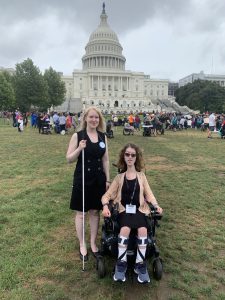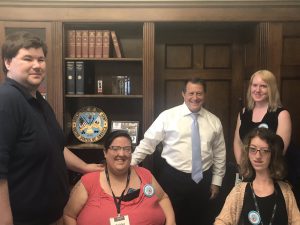I worked in Cincinnati, Ohio, with Council Member P.G. Sittenfeld and his office. I worked mainly in the office, but I accompanied the staff to nearly-daily meetings with constituents and community members, participated in tours and press conferences, and observed council/committee meetings.
I worked with the two staff members, Jazz and Chris, to brainstorm the City response when there were shootings downtown—an experience very pertinent to our discussion of gun violence this year. Congressman Tim Ryan also held a press conference outside of City Hall in response to the Dayton shooting, and I got to participate and meet him! I also got a glimpse of the wide broach of subjects in which city officials are required to be versed: environmental policy, gun violence, affordable housing issues, among many others. The battle between development and affordable housing provisions was a constant fight I witnessed during my time at City Hall.
Heading into this internship, I had the intention of identifying problems and disconnects within the council and interwoven throughout their relationship to the community. Here are a few of my observations thus far, in brief.
The relationship between the media and the City Council is shifty and strategic, at best. Many reporters for the Cincinnati Enquirer have quotas to fill and, when there’s nothing of true notice happening in Cincinnati, the reporter is obligated to use a little creativity. One such example is the “scandal” surrounding five of the councilmembers; donned the “Gang of Five,” these members have been repeatedly targeted for communicating with one another in text messages. The Enquirer continues to resurface and rehash this scandal which, of course, translates into this issue becoming most important in the eyes of the public. Little coverage was given to significant Council achievements — like passing a $1 billion+ budget — and more is given to objectively less-important problems like the “Gang of Five” or the streetcar drama. Chris, PG’s chief-of-staff, “feeds” one of the main reporters information to write about and subjects that will instigate less drama.
It’s a precarious balance, and one that I wish weren’t necessary. Clearly, the news has to report something, and reporters are hardly to blame for digging and grasping at juicy straws. Little incentive exists for news agencies to present information accurately or at least without skewing relative importance. And even if incentive did exist, some of the more important issues like the budget will not pull in clicks, which can be harmful for the success of the organization. When the media (newspapers, blogs, and talk radio) is the only source of information for a disconnected public, the issue seems hopeless; if media does not portray reality, the public has no other way of knowing what really goes on at City Hall and in their government.
This, of course, is an issue embedded at the heart of national and international politics. Media has somewhat unchecked power in regard to what it feeds the public. But, it is important to remember that this is not a binary situation—often, reality is much more dry than media representation, and the public craves drama. This craving is rooted in biological motivations (see various studies on the amygdala and its response to crisis/excitement), so is it possible to ever reroute a public which thrives on bad news? Although this issue is something I’m passionate about (and wrote about in my Common Application essay), I don’t think that this is a job I would ever want to take on. While it is fast-paced and exciting and you get to meet/correspond with many new people, the politics is often just off-putting. I knew this would be the case going in, but I think that this experience has further cemented in my mind that I will likely not pursue politics as an elected official.
However, this was an incredible summer experience and one that I’d recommend to anyone, whether they have an acute interest in local government or not.

City Hall, my home for the summer

Meeting Congressman Tim Ryan in a press conference on gun violence!
Today was my last day as a Policy Intern for the Center for Disability Rights (CDR), a disability advocacy organization headquartered in Rochester, New York. Because of my own disability, I was able to intern remotely from the comfort of my home in Maryland instead of relocating to New York for the summer. I had a variety of tasks that taught me about the local, state, and federal government advocacy process.
Throughout the summer, I did research on a wide range of topics that affect people with disabilities. These topics weren’t always things I traditionally associated with disability, but because of my internship, I learned that pretty much any policy issue relates back to disability. For example, I researched opioids and how they help people with chronic pain, automatic vehicles and their potential to increase independence for people with disabilities, rentable micromobility scooters and how they block walkways, gun violence and how blaming it on mental illness increases stigma, and much, much more. Every day was different and educational. I would often take what I learned and turn it into a social media post for CDR.
One of my biggest projects this summer was writing an official position paper for CDR about increasing political engagement by people with disabilities. I thought about how we as a society can make sure people with disabilities are included in the political process, from voting to supporting campaigns to participating in government events to running for office. Especially with the upcoming election, it is essential that people with disabilities feel empowered to mobilize and show up to vote. However, there are often both physical and societal barriers that prevent people with disabilities like myself from being able to fully participate in the political process. I am excited to continue this focus on political engagement throughout the year in my Advocacy and Policy cohort.
The most exciting part of my summer was when I went to a week-long conference in Washington D.C. held by the National Council on Independent Living. Disability advocates from around the country and even the world got together to learn from each other and organize as a collective group to make an impact on disability policy. I participated in engaging workshops, met amazing people, and most importantly, put my advocacy skills to the test during a day on the Hill. A big focus of the conference was the Disability Integration Act, which allows people with disabilities to get the services they need at home and in the community instead of in an institution. We participated in a march to the Capitol and then held a rally outside the building where important members of Congress spoke, including Chuck Schumer, who introduced the Senate version of the bill. I appreciated getting to hear from legislators who were making an effort to support Americans with disabilities. Then, I got to meet with staffers from Senators Schumer and Gillibrand, as well as a staffer for one New York Representative and an actual Representative himself, who seemed way more engaged than the staffers. I loved getting to talk to members of Congress and their staff and explaining why they should support or oppose certain bills. It was so cool to spend time on Capitol Hill surrounded by the people who keep our government running. I even ran into Bernie Sanders while crossing the street!
My internship showed me that I want to pursue a career in disability advocacy after college. Advocacy is not always easy, but this summer I learned how important and rewarding it really is. I am so grateful for this amazing experience.

My boss and I outside the Capitol

CDR Staff and I with Representative Joe Morelle
By Leyla Arcasoy
This summer, I’m interning at Memorial Sloan Kettering’s Immigrant Health & Cancer Disparities Service. The work that we do at the IHCD revolves around limiting and overcoming the disparities that vulnerable populations face when it comes to access to healthcare, more specifically, cancer care.
So far, I have two major roles at my internship: I spend my mornings distributing food at our pantries to cancer patients, and I spend my afternoons doing research on the services provided for cancer patients throughout the city and nationwide. At pantry, we provide food that often supplements the patients’ diets, like fresh produce, beans, grains, and fruit. The patients are always cheery and greet us with smiles on their faces. It’s been a really great and valuable way to participate in a tangible form of service in my internship this summer.
At the office, I spend the majority of my time doing research on the different services available for cancer patients, like financial assistance, transportation services, and quality of life assistance. Every week, a seminar is held for the interns, where either one of the staff members or a guest speaker gives a lecture about one or some of the barriers to cancer care experienced by the vulnerable populations that we serve.
A great perk: I’m one of the youngest interns at the office, in fact, the youngest, and it’s been an interesting part of the experience. I get a lot of advice from the staff members and the other interns, the majority of which are either upper classmen, graduate students, or medical students ranging from navigating the intern experience to getting through my undergraduate career and figuring out goals for the future.


(Some pictures from my commute in the city!)







